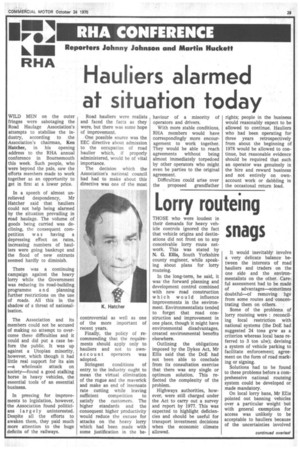Lorry routeing
Page 31

Page 32

If you've noticed an error in this article please click here to report it so we can fix it.
THOSE who were loudest in their demands for heavy vehicle controls ignored the fact that vehicle origins and destin ations sna s did not front on to any conceivable lorry route network. This was stated by N. G. Ellis, South Yorkshire county engineer, while speaking about plans for lorry routeing.
In the long-term, he said, it was the forward planning and development control combined with new road construction which would influence improvements in the environment. Environmentalists tended to forget that road construction and improvement in one place, though it might have environmental disadvantages, created environmental benefits elsewhere.
Outlining the obligations imposed by the Dykes Act, Mr Ellis said that the DoE had not been able to conclude from its consultation exercise that there was any single or optimum solution. This reflected the complexity of the problem.
Highways authorities, however, were still charged under the Act to carry out a survey and report by 1977. This was expected to highlight deficiencies and should be useful for transport investment decisions when the economic climate allowed. It would inevitably involve a very delicate balance between the interests of road hauliers and traders on the one side and the environmentalists on the other. Careful assessment had to be made of advantages—sometimes doubtful—of removing hgv from some routes and concentrating them on others.
Some of the problems of lorry routeing were : reconciling local restriction with national systems (the DoE had suggested 24 tons gvw as a criterion whereas local bans referred to 3 ton ulw); devising a system of vehicle parking to facilitate enforcement; agreement on the form of road marking or signing.
Solutions had to be found to these problems before a comprehensive national routeing system could be developed or made mandatory.
On local lorry bans, Mr Ellis pointed out banning vehicles over a particular weight but with general exemption for access was unlikely to be acceptable to hauliers because of the uncertainties involved
continued from page 29
and to the local authority be'cause of the difficulty of enforcement.
Those who drafted restriction should bear in mind that enforcement was difficult where restriction were partial; attention should be paid to the adequacy of alternative routes; daytime restriction exacerbated night noise problems; bans limited to very heavy vehicles afforded only limited advantages because there were fewer of these vehicles.
It should also be remembered that the use of large vehicles was not only economical for the operator but also in the use of road space. Of course the really big vehicle posed problems in the urban environment and the co-operation of hauliers was sought to minimise this.
Illustrating with slides the problems caused by parking particularly overnight, Mr Ellis suggested that an insistence by operators on overnight depot parking and a reciprocal arrangement with operators in other towns would help.
A national network of strategic lorry parks sponsored by the DoE now seemed unlikely.
Particularising on the approach made by the South Yorkshire authority in various locations, Mr Ellis pointed out that problems developed over many years could not be solved overnight.
It was important that authorities should put forth solutions which seemed reasonable not only to the public but also to the haulage industry which served it. Whatever extra costs were occasioned by restriction would be passed on to the public and a middle way had to be sought which gave substantial benefits to the community at an acceptable cost.








































































































